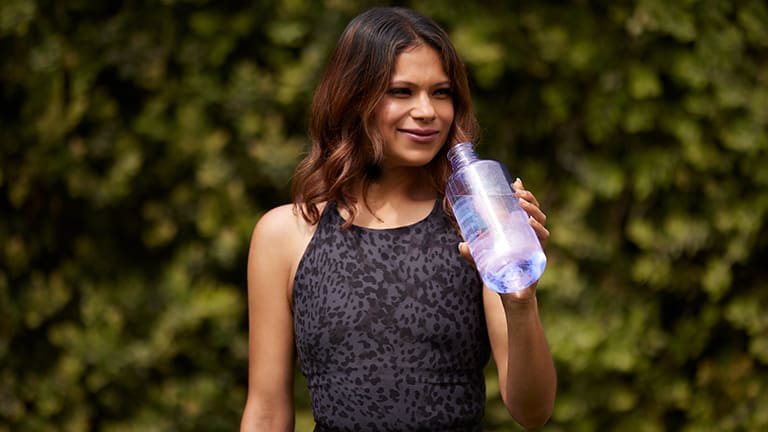How to Exercise in the Heat


When exercising in hot weather, there is one guarantee: You will sweat—a lot! While walking outside is a refreshing way to mix up your treadmill routine, there are a few precautions to keep in mind as the temps start to rise. “Heat has a major effect on our fitness capacity,” explains Ashleigh Kast, a New York City–based trainer and founder of Sophisticated Strength. Respect that influence and dial down your workout to avoid heat exhaustion, sunburn, and dehydration.
The best way to avoid these potential pitfalls is to be prepared. Wearing the correct clothing, staying hydrated, and walking during optimal hours will help ensure you have a successful workout.
Here, three fitness professionals share the most important things you need to know to safely walk in the heat:
1. Rise, shine, and start walking.
Temps tend to be more bearable first thing in the morning or later in the day when the sun isn’t directly overhead, explains Michelle Lovitt, an exercise physiologist and trainer in Los Angeles. No matter what time you go for a walk, always wear sunscreen, she adds. If you have to work out during the middle of the day, consider shortening the length of your walk to avoid overexerting yourself in the hot weather.
Related: Why now is the time to become a morning exerciser
2. Start planning the night before.
Staying properly hydrated is always important, and it’s extra important when you’re exercising in the heat. During your workout, experts at the American Council on Exercise recommend drinking seven to 10 ounces of fluid every 10 to 20 minutes. “Freeze a water bottle the night before and carry it with you,” says Lovitt. “It will keep you cool and hydrated during your walk, especially as the ice melts.”
Related: How much water should you drink every day?
3. Keep tabs on the humidity.
It’s not just the temperature that matters—relative humidity plays a big role in how hot it feels during your outdoor walk, explains Lovitt. “Humidity impacts the ability of the body to cool itself off because sweat doesn’t evaporate from the skin [quickly]. As a result, the temperature feels much hotter than the temperature actually reads.”
4. Wear the right sneakers to avoid blisters.
When the temps are hot and you’re sweating (everywhere), blisters are a major concern—and a major workout buzzkill. “Wear a shoe that breathes and fits just right,” explains Kast. In addition to the fit, take the material into consideration. Look for airy mesh or a light fabric and avoid leather sneakers if possible, she adds.
In the market for a new pair? Check out the WW x New Balance Get Walking Kit. The bundle includes a 45-page digital guide that’s packed with expert tips and tricks, plus a rundown of top walking-sneaker styles from New Balance to help you find your perfect fit. You’ll get a credit to bring home your new pair of kicks, along with extra gear that you can use on hot-weather walks like a water bottle and cooling towel.
5. Know the signs of dehydration.
It’s natural to feel sweaty and tired when you’re exercising. It is called “working out” for a reason. However, when you’re exercising in the heat, it’s important to be diligent about looking for symptoms of exhaustion or dehydration. Feeling nauseated, experiencing dry mouth, losing color in your skin, and feeling confused, dizzy, or faint are potential warning signs explains Lindsey Clayton, a New York City–based trainer and co-founder of the Brave Body Project. “If you're excessively sweating, light-headed, or nauseated, you should take your walk indoors or shorten it,” she says.
6. Use smarter intervals.
Instead of heading outside and logging high-mileage walks, aim for a shorter workout of speed-walking intervals or tackling a few incline hills. If you’re doing an interval workout of walking bursts followed by recovery periods, extend your rest breaks longer than normal. Kast suggests keeping a 1:1 work-to-rest ratio or one with a higher rest period.
Related: Exercise intensity and how to use it
7. Dress the part.
Your inclination may be to go as bare as possible, but a shirt that wicks away sweat and has some room and can be a great makeshift towel for wiping sweat or dirt off your face is a better choice, explains Kast.
Related: Find workout clothes that make you feel good
Finally, discuss with your doctor whether it is safe for you to exercise in hot temperatures.
--